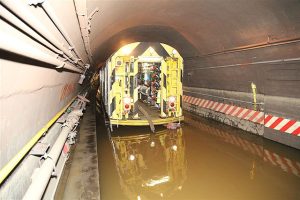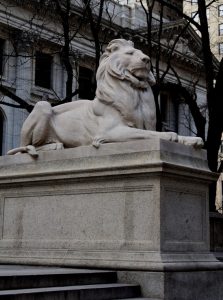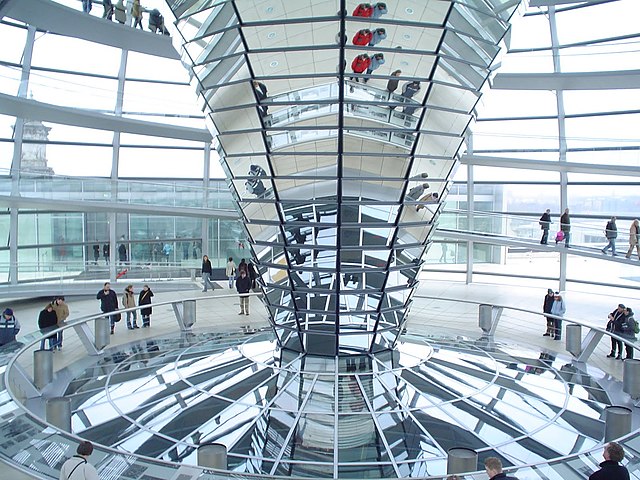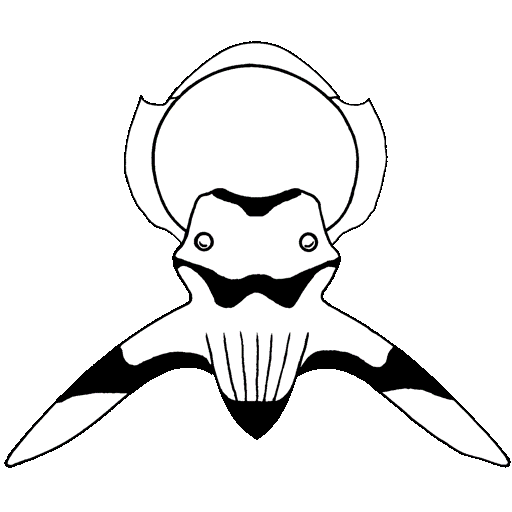Full disclosure: Adam Lee is a longtime online friend and one of my favorite bloggers. We have read and critiqued each other’s writings for years. This review emerged from one of those exchanges.
I have never read Ayn Rand’s famous novel, Atlas Shrugged. What I know of it I learned through reading several installments of Lee’s thoughtful and detailed review of that book, in which he emphasized the extraordinarily selfish nature of Rand’s worldview — so selfish as to border on psychopathy. It’s easy to experiment with social engineering in fiction: pesky constraints so often encountered in the real world vanish at the whim of godlike authors. What if reality had intruded into Rand’s imaginary world? Or, more plausibly, what if a libertarian utopia modeled on Rand’s ideology were unleashed in reality? How would it really turn out? These questions inspired Lee to create his own imaginary world, one in which the realities of human nature and global ecological constraints collide with unfettered libertarianism.
Commonwealth: A Novel of Utopia is the result. The novel is divided into three parts, each comprising about a dozen chapters. In part 1, Lee drops the reader into New York City near the end of the twenty-first century, where it’s hot and muggy in May, yet snow is falling: greasy, black flakes that stain the skin and clothing of the story’s protagonist as she walks from the subway to her apartment.

Rae Robinson is a young, hard-working engineer who struggles to keep New York’s antiquated subway system running in a society that slavishly exalts private enterprise to the detriment of public infrastructure. In the first few chapters we see her austere apartment, in which every use of a shower or microwave oven requires the swipe of a credit card. We meet her friends from college days, whose idealism is sorely tested by life in “The United Free States of America,” as the nation is now known. We learn that the black snow is fallout from garbage incinerators in the flooded ruins of Newark — one of several “reclamation zones” surrounding New York that have been abandoned to the rising ocean. New York itself is likewise threatened, spared only by its gargantuan but neglected sea walls.
We also learn, during conversation over Rae’s potluck dinner for her bookish friends, about the prisoner’s dilemma: a classic thought experiment from game theory that pits cooperation against competition and empathy against selfishness. The point is that life is full of situations in which cooperation yields the best outcome for all, yet selfish impulses often dominate and lead to behavior that is ultimately detrimental — a metaphor and partial explanation for the societal decay that weighs heavily on Rae and her friends. This is only the first of several such digressions, placed at critical junctures throughout the novel, where Lee skillfully weaves mind-stretching ideas from philosophy and science into his narrative. Some readers may struggle with this, but I found the effort rewarding.

I also found the story engaging. In the remainder of part 1, Rae valiantly tries to keep the trains running, despite inadequate resources and toxic co-workers. In her off hours she seeks political redress for injustices close to home, with little effect. In the process, however, she stumbles upon what appears to be a dark conspiracy headed by her ex-lover, Will Anton, who now leads Anton Aerospace, a high-tech military corporation. The pace accelerates as she delves into this, and Lee’s vivid prose is utterly compelling. In one of my favorite passages, Rae uses her technical skills to break into the defunct and boarded-up New York public library to pursue her investigation of Anton. The scene is a beautiful if painful metaphor for a society that has lobotomized itself:
Now the library was a ruin, laid low by thirty years of neglect. Its white Vermont marble facade was shot through with cracks and grimy with pollution. Its sculptures were crumbling like sugar, softened by decades of acid rain. Weeds sprouted through cracks in the marble steps. Pigeons roosted on grand chandeliers inside the building, flying freely in and out of the arched windows that had been broken by wind and storms. The building seemed sunken and shriveled, like a desiccated corpse.
On either side of the entrance staircase, the two stone lions Patience and Fortitude were entwined in leafy vines that had enveloped their pedestals. Their sad, solemn faces looked out on the desolation.
It’s hard to believe they never demolished this place, Rae thought. Unless they left it like this deliberately, to send a message…
The inside of the library was pitch-black, but Rae had expected that. She strapped her headlamp on and kindled the light.
It revealed an eerie scene. The grand staircases with their sweeping balustrades, the ornate lamps that hung from the ceilings of the vaulted hallways on brass chains, the ceiling murals of mythological figures and angels – except for the broken windows, everything was intact, as if the caretakers had departed only yesterday. But the building smelled of mildew and damp rot, and fallen leaves littered the corridors in decaying drifts.
Her footsteps echoed in that silent place. As she walked, shadows shifted and moved, herded by the beam of her headlamp. In alcoves along the walls, marble busts of artists and civic figures watched her with sightless eyes. As she passed each one, the light briefly threw their profiles in silhouette on the wall, as if the old ghosts had stirred to see who disturbed their slumber.
Unable to help herself, Rae peeked into the main reading room. Long rows of mahogany tables awaited readers who would never come again. The high shelves that lined the walls were still filled with books. Some merely looked dusty, but in other places, water had dripped through broken windows and turned priceless antique volumes into piles of black mold. Mushrooms sprouted from shelves in fairy rings. Dead vines clung to chairs and lamps like cobwebs.
Lee wrote Commonwealth during the rise of Trumpism in America, and this is reflected in the themes that dominate part 1: growing income inequality, the cult of selfishness, corporate influence in government, environmental neglect, denial of global warming, and creeping authoritarianism. Yet some of it is astonishingly prescient. Consider this passage, written a year or more before the Covid-19 pandemic and the Trump cult’s denialism, rejection of vaccines, vilification of Fauci, and extolling of Ivermectin:
Cholera and dysentery crept back into New York City. They appeared in the reclamation zones first, but spread slowly, inexorably, into wealthy neighborhoods. In their wake came other waterborne diseases: typhoid fever, rotavirus, leptospirosis, norovirus, giardiasis. On ten thousand sickbeds, men, women and children retched, vomited and convulsed. The city Department of Health had been shut down as an infringement on liberty and property rights, so there was no one to order quarantines, and the sick went out and contaminated every surface they touched and began the cycle of contagion anew.
Meanwhile, other diseases began reappearing, spread by rats, flies and mosquitoes: first bubonic plague, then malaria, yellow fever, dengue fever, chikungunya, West Nile virus, St. Louis encephalitis. In the feverish heat of the summer, a thousand pathogens found fertile soil, grew and swelled. An old darkness, once banished by public hygiene laws, woke from its long sleep and stretched subtle fingers into the crevices of the city.
As reports of the spreading epidemics appeared on the nightly news crawls, the rich hoarded antibiotics and antivirals, strung mosquito netting over their patios and balconies, and had truckloads of bottled water shipped in at great expense from far-away reservoirs. The poor dragged themselves to free clinics, where besieged and underfunded doctors could offer little help, or turned to quacks and snake-oil salesmen who popped up on street corners, hawking dubious nostrums at inflated prices.
As society crumbles in part 1, so does Rae’s personal life. Her friends are arrested, she loses her job, and her current boyfriend betrays her to the authorities. With the police on her heels, she turns in desperation to her wealthy ex-lover, Will Anton, whom she reviles for selling out to the corporatocracy and whose dark secrets she has not yet fully uncovered. With no time to explain himself, Anton engineers Rae’s dramatic escape from New York in one of his corporation’s most sophisticated jet aircraft. Bewildered, yet intrigued by the advanced technology of her conveyance, Rae is sent streaking across the continent toward the Pacific Northwest, where her life and the novel take a radical turn from dystopian to utopian.
In part 2, Rae crash-lands in the Pacific Republic, a society that rose from the ruins of the Pacific Northwest after that corner of America had been wiped out, in 2064, by a catastrophic earthquake on the Cascadia fault and the tsunami that followed. Rae is gravely injured in the crash, but the astoundingly advanced medical technology of the Pacific Republic quickly repairs the damage. Like the protagonist, the reader may be stunned and disoriented by the abrupt turn of plot. Along with Rae, we gradually learn about the catastrophe that wiped clean the slate of American civilization from its northwest corner, leaving a small and desperate population who could only survive through cooperation. In the span of about one human generation, they advance from a Neolithic existence to a level of technology rivaling Star Trek, and it is the near-optimal balance of cooperation and competition in their society that has made this possible.
My initial reaction to this was overwhelming skepticism, not so much at the suggestion that such a society is possible, but mainly at the idea that it could arise so quickly. My lifetime of experience in science and engineering — including many painful lessons in the laws of Murphy and Hofstadter — told me otherwise. But after reading the first few chapters of part 2 and recalling the philosophical digressions of part 1, I accepted the story for the allegory it is and suspended my more literal-minded disbelief. Though I had found the plot of part 1 readily believable, I came to see in part 2 that Lee is not trying to tell a plausible story. He’s trying to expand our appreciation of the vastness of the universe that comprises all possible human social systems. The story is an entertaining device that points out some of the worst and best places in that many-dimensional space.
The Pacific Republic illustrates Lee’s optimism concerning human potential, and he paints the picture with a mind-stretching sci-fi narrative. Rae’s first experience of utopian existence is a vague, dreamlike state:
Rae floated deep beneath an ocean of black water. She was suspended, weightless. Her hair spread out in a fan around her head. Her arms drifted at her sides. She couldn’t tell if she was breathing or not, but somehow it didn’t seem important.
She was aware of immense gulfs surrounding her, unfathomable infinities of time and space through which she could sink forever and never reach the bottom. She knew herself to be microscopic and insignificant, an atom of life falling endlessly through a starless cosmos. But in a way, it was comforting. She felt embraced, as if the dark had reawakened a peaceful memory of the womb.
Dimly, like a shaft of sunlight from high above, she was aware of things happening around her. There were colors and sounds, but distant, muted. She felt strange sensations – pricking, tingling, burning, pressure – but they seemed to be coming from far away, easy to ignore.
And besides, she couldn’t find it in herself to care. Her mind was as placid as the midnight sea.
She then awakens in a hospital room, where a physician explains, as best she can, the severity of Rae’s injuries and what has been done to treat them. She then tries to get the patient on her feet:
“Come to the window,” the doctor invited her. “Sun and fresh air will help you get your bearings.”
Rae essayed a step. Again she felt briefly wobbly, as if her body had forgotten this, but muscle memory reawakened almost immediately. She could walk. She came over to stand by the window.
Dr. Singh pulled the curtain back.
Despite her newfound balance, Rae almost fell over.
It was a city, but unlike any she had ever seen or imagined.
Glittering towers rose out of sight, impossibly tall. Zeppelins hung in the air between them, great golden craft that moved with weightless grace despite their ungainly round shapes. Sleek, silvery aircraft reminiscent of birds and dragonflies swooped and darted in the distance, in a sky that was an intense cerulean blue touched with wispy white streaks of cloud.
At the feet of the towers grew a profusion of living greenery. Dense groves of shade trees alternated with open meadows or parks of manicured grass. Somehow, the immense skyscrapers contrived to blend in with the pristine natural setting, as if nothing could be more fitting than that they should be there.
Rivers wound through the parks and woodlands and looped around the feet of the towers in lazy blue curves. Colorful small boats moved along the water. Suspension bridges that looked like glass cobwebs spanned the banks of the rivers, so light and airy they were almost transparent, refracting the sunlight into shimmering pastel rainbows.
The question that had been sticking in her throat since she had awoken finally burst out of her.
“Where am I?!”
Dr. Singh looked contrite.
“My apologies. I had assumed you already knew. Welcome to the Pacific Republic.”
It was too much to take in. Rae clutched the windowsill. It felt as if her grasp on reality was slipping, as if the world was crashing down around her.
Yet Rae soon regains her strength, and through her eyes we are introduced to the wonders of a nearly optimal social system, one in which both the cooperative and competitive impulses of human nature are directed toward a broadly-based flourishing of humanity. There is money and work, but money is entirely digital and traceable — a potent disincentive to crime and corruption. A dignified but minimalist life is guaranteed for all, but prosperity beyond that requires work. There is strong emphasis on education, science, technology, and the arts, but each individual is free to pursue his or her talents and passion. A recurring theme is that government should be minimally intrusive, yet robustly dedicated to ensuring environmental sustainability, peace, and prosperity through the shaping of social incentives, rather than by direct control of the lives of individuals.
Of course, it’s not always obvious what those incentives should be. In the Pacific Republic they are engineered, adjusted, or discarded as necessary by a legislature called the Assembly. Rae first visits this institution not as a tourist, but as a witness who can testify to conditions in the United Free States of America. I love Lee’s portrayal of the setting, as does one of the characters:
“I love this part,” he said with a grin.
The lights dimmed, just for an instant, and the chamber darkened. When the lights came back up, something was different.
The great glass cylinder that wrapped around the legislative chamber had changed. Before the meeting was called to order, the faceted glass panels had been frosted, translucent. Now they were transparent, but what they showed wasn’t the building outside. Instead, it showed people: row upon row of them, a gathered crowd of observers stretching away into an impossible distance. It was as if the chamber was a theater in the round, and they were beneath the gazes of a vast audience.
“These sessions are livestreamed,” he explained in a whisper. “The partitions are smart glass. They display an avatar of everyone who’s watching. Jane says it helps the legislators remember that the public’s eyes are on them.”

This scene may be a tribute to the restored Reichstag building in Berlin, with its transparent dome that literally allows citizens to look over the shoulders of their legislators — a temple of democracy that rose from the ashes of both right- and left-wing dictatorships.
On the occasion of Rae’s testimony, the Assembly is considering a profoundly moral question: should the Pacific Republic try to save the suffering, dysfunctional society that occupies most of the continent, even if it means going to war? When is war justified? What obligations do we have to our fellow humans? Are we truly free if most humans are not? These are the philosophical threads that permeate part 2, but the plot also takes big leaps.
We learn that Will Anton had been recruited as an agent of the Pacific Republic and that his corporation, Anton Aerospace, was in fact a tool for infiltrating the American military-industrial complex — discovering its weak points and surreptitiously engineering new ones — all with a view to the war of liberation that seemed increasingly inevitable. As this war is debated and planned, Rae wrestles with her long-held contempt for Anton, which she now sees had no basis in fact. He, too, has now escaped to the Pacific Republic, and gradually their romantic flame is rekindled.
Rather than reveal any spoilers, I will only say that part 3 takes yet another sharp turn. The war begins with a covert invasion, followed by rapid escalation. The Pacific Republic has the advantages of technological superiority and high morale, but it is vastly outnumbered by its enemy. For Rae, the invasion offers hope of rescuing her closest friends, who still languish in a squalid prison. The action is intense, suspenseful, and cinematic. Although the scope of the novel may be too much for a movie, I can easily imagine it as a compelling series on Netflix.
I began this review by pointing out a glaring flaw in Ayn Rand’s Atlas Shrugged: it’s easy to write a novel that illustrates the virtues of your political ideology, but the exercise is pointless if real-world constraints would render it impossible in practice. The same criticism can be leveled at Adam Lee’s Commonwealth. Setting aside the issue of how long it would take to get there, is a society like the Pacific Republic a realizable goal? There’s a hefty dose of Enlightenment optimism in part 2 of Commonwealth, including the view that much of individual human behavior is determined by environmental factors and upbringing. Lee never suggests (and does not believe) that the individual human mind is born a blank slate, yet he implicitly suggests something akin to this at the level of human societies: the Pacific Republic developed from a blank slate after a huge earthquake and tsunami completely erased the society that preceded it. At the very least, he seems to be suggesting that such a radical change in society is faster or more likely if we just wipe the slate clean and start from scratch. Also, at several places in part 2, the characters who are explaining the Pacific Republic to Rae emphasize the importance of environment as a determinant of human behavior. Here are two examples:
“The most important principle we put into action here is that people learn how to behave by taking cues from their environment and culture.”
“These are normal men and women, not a superior race. Humans are creatures of their environment; they respond to the incentives they’re given. We’ve just done a better job of designing our society to get those incentives right.”
I worry that Lee may be unrealistically downplaying the role of heredity and the innate intuitions that also shape human behavior. Twin studies find significantly heritable contributions to nearly all aspects of human personality and behavior. Also relevant here are the findings of Jonathan Haidt on innate moral intuitions. Of course, Lee knows this literature: his series of essays on Reengineering Human Nature is all about the reality and evolutionary origins of human nature.
Cooperation is the essence of the Pacific Republic and its success, but cooperation and competition appear to be two sides of the same coin in human nature. We evolved to cooperate in small tribes of maybe 50 to 100 members, in part to fend off attacks by the neighboring tribes against whom we compete. Nothing enhances cooperation and group cohesion more than external threat—a fact exploited by cult leaders, dictators, and a recent president. Fifty years ago the Apollo program was a triumph of human cooperation, spurred on in part by the threat of our Cold War rivals.
Given these aspects of human nature, how cooperative can a human society realistically be? I’ve wrestled with this question myself, especially in my writings about cults. Like Lee, I try to take an optimistic view—that we can teach our children to emphasize kindness and cooperation and to see through narcissistic bullies rather than follow them. I’m not saying that Lee’s utopian Pacific Republic is impossible, only that getting there, or somewhere near there, will be a struggle against the dark side of human nature, which will always be with us.
Those last few paragraphs should convince you that reading Commonwealth was for me a deeply rewarding, mind-expanding, and thought-provoking experience. I highly recommend it to anyone who wonders where humanity is heading, where we should try to go, and how best we might get there. The book is currently available at the author’s Patreon website.
Share this: